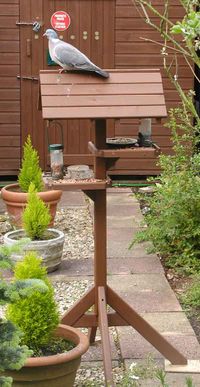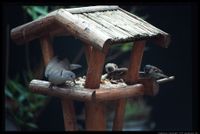
A bird table, with a Wood Pigeon on the roof, in
an English garden. The table provides water,
peanuts, sunflower seeds, and a seed mix
Bird feeding is the activity of feeding wild
birds.
While
birdwatchers seek out birds by species, bird feeders
attempt to attract birds to suburban and domestic locations.
This requires setting up a feeding station and supplying
bird food. The food might include seeds, peanuts, bought
food mixes, fat and suet. Additionally, a birdbath and grit
(sand) that birds store in their crops to help grind food as
an aid to digestion, can be provided.
Certain foods tend to attract certain birds.
Finches love niger thistle seed.
Jays love
corn.
Hummingbirds love
nectar. Mixed seed attracts many birds. Black oil
sunflower seed is favored by many seed-eating species.
Feeding stations should be located near natural cover.
Birds prefer not to be exposed. Therefore, putting a bird
feeding station by a window will attract only especially
gregarious birds (such as
sparrows and
starlings). While the viewer will want to have a clear
line of sight to the feeding station, it is important for
the station to be near shrubbery or a tree. If the station
is too close to a tree or shrub, pests such as
squirrels may find access to the station easy. Locating
feeders near low cover gives predators such as cats a hiding
place from which to launch an ambush. Birds are messy
eaters. If the feeding station is over dirt or a lawn, whole
cereals and unshelled sunflower seeds will germinate beneath the station, while shelled nuts and
degermed cereals will not.
After the station is established, it can take some weeks
for birds to discover and start using it. This is
particularly true if the feeding station is the first one in
an area or (in cold-winter areas) if the station is being
established in spring when natural sources of food are
plentiful. Therefore, beginners should not completely fill a
feeder at first. The food will get old and spoil if it is
left uneaten for too long. This is particularly true of
unshelled foods, such as thistle seed and suet. Once the
birds begin taking food, the feeder should be kept full.
Additionally, people feeding birds should be sure that there
is a source of water nearby. A bird bath can attract as many
birds as a feeding station.
Generally, bird feeding is environmentally neutral or
helpful. However, birds can become dependent on artificial
food supplies, and feeding can upset the natural balance
between different species. This is especially true of
invasive species, such as, in the US, European starlings and
Eurasian tree sparrows, which can increase in numbers due to
feeding and displace native populations. Some bird feeders
therefore attempt to select foods and feeding stations that
can discriminate between desired and invasive species. Some
species are considered "trash" birds because they are
sighted so often. If there is concern about fostering
invasive species, it is best to feed during winter, when
birds most need food, to taper feeding activity in spring,
and to increase again in fall, when fledging will have taken
place and local populations will be higher.
Different feeders can be purchased specialized for
different species. Persons living on
migration routes should especially feed during the
migration times (which may be year-round), as feeding will
not be likely to artificially promote local populations.
During spring feeders make up less than 25% of a birds diet
but during winter months the birds will turn to the feeder
which they have come to know as a dependable food source.
When bird feeding, be sure to take hygiene and safety
precautions, as the unnatural situation of having large
numbers of birds congregating in one area can lead to
transmission of infectious diseases. Clean all feeding
stations regularly and wash away all droppings. Wear rubber
gloves when undertaking these tasks to avoid contact with
bacteria and viruses that may be present in bird droppings.
Other safety precautions involve not feeding whole peanuts
or unsoaked dried fruit during the breeding season as this
can be dangerous to nestlings, and never using net bags to feed birds, as
birds may die as a result of their feet or tongues getting
trapped.
Large sums of money are spent by ardent bird feeders, who
indulge their wild birds with a variety of wild bird seeds,
suets, nectars (for hummingbirds), and special flower
plantings. Bird feeding is regarded as the first or second
most popular pastime in the USA. Some fifty-five million
Americans are involved in bird feeding. The activity has
spawned an industry that sells birdseed, birdfeeders,
birdhouses (nesting boxes), mounting poles, squirrel
baffles, binoculars, etc.
The ten commonest birds reported in U.S. gardens are, in
descending order:
- Northern Cardinal
Mourning Dove
Dark-eyed Junco
American Goldfinch
Downy Woodpecker
Blue Jay
- House Finch
Tufted Titmouse
American Crow
Black-capped Chickadee
- (from the 2005
Great Backyard Bird Count)

Bird table in
Blokker,
The Netherlands
The ten commonest birds in British gardens are, in
descending order:
- House Sparrow
Common Starling
Blackbird
Blue Tit
Chaffinch
Greenfinch
Collared Dove
Wood Pigeon
Great Tit
Robin
- (from the 2006
RSPB Garden Birdwatch. See also the RSPB's list of
the twenty commonenst garden birds[1])
In some cities or parts of cities (e.g.
Trafalgar Square in London) feeding certain birds is
forbidden, either because they compete with vulnerable
native species, or because they abound and cause pollution
and/or noise.
External links




